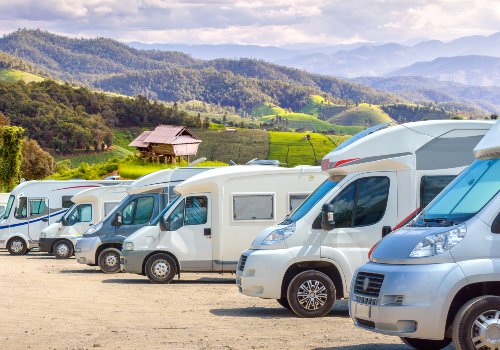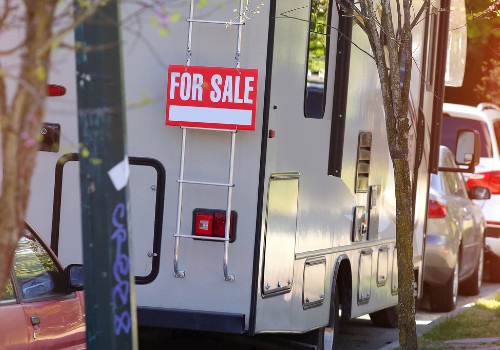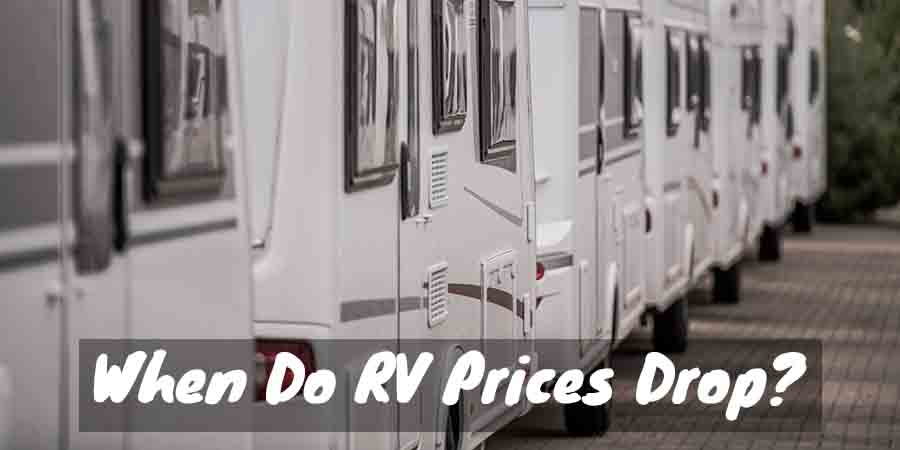Shopping for a new or used RV?
Doing so when prices drop can save you thousands, so when’s the best time to look?
The answer depends mostly on where you live, as prices fluctuate between the busy and slow RV travel seasons. That’s why this guide to RV price drops will benefit anyone looking to purchase a recreational vehicle soon.
Inside, you will find the best time to get the lowest prices according to your region and when dealers are most willing to liquidate inventory to make room for new models.
The best part about following this guide is the money you save that can go toward your first RV adventure!
When Are RV Prices Lowest?

RV price drops are most common in the fall and winter months when private sellers and dealerships are looking to unload. Nobody wants to pay for months of storage or have them taking up space in the sales lot.
Dealership Price Drops
Off-Season
Look for the lowest prices at RV dealerships during fall and winter. October is the ideal month to start shopping in colder climates, as most people are busy prepping for the holidays and not remotely thinking of buying an RV.
Dealers are itching to lower inventory during this time and offer great incentives that mean lower sticker prices and extra perks like extensions of warranty or memberships to RV travel clubs.
Hem and haw over your purchase and see what the salesperson offers. The longer you can hold out, the more they will reduce the price, especially if your credit is good, and they know a sale will go off without issues.
Both new and used RVs have a reasonably good profit margin for negotiation, so don’t get attached to a particular RV and fall for the “we have lots of other interested parties” pitch that can panic you into a purchase.
December and January are possibly the absolute best months to purchase, as whatever inventory is on the floor needs to move, even if the profits are slim.
Before New Models Arrive
New RV models typically arrive in early spring, which increases the need to sell off old inventory.
People who are planning for spring or summer RVing trips begin shopping in earnest in mid-to-late February, and dealerships draw a hard line on discounts at this time. They know the active selling season is underway and are much more reluctant to offer enticing deals because those RVs are going to fly out the door without them.
Dealership Buying Tips
TIP #1: Even if you live in the south, don’t be afraid to travel north to get a deal on the RV of your dreams. It’s common practice for southerners to fly to a dealership up north when prices are lower, buy an RV, and drive it back home, using some of the savings to cover fuel expenses.
TIP #2: Avoid dealerships on the weekends. More people are shopping at this time, which means you will not only have more trouble lingering inside RVs trying to get a real feel of the space, but salespeople will also have less time to devote to answering your questions or running numbers.
Warmer Climate Dealerships

RV dealerships in more temperate regions of the country have a steady stream of customers all year long, trying to sell, trade, or buy a recreational vehicle.
The best time to purchase in a specific warm region needs a bit of online research on what time of year is slowest for sales, making RV prices drop. Even areas within a state can fluctuate in timing for the best deals.
Remember that full-time RVers stalk back and forth across the southern states taking advantage of warm winters. They often stay to enjoy the tranquility of the non-touristy months such as September thru November in Florida or May and June in New Mexico.
It’s not uncommon for “snowbirds” in the winter or foreign travelers who take months-long RV holidays in the summer to purchase an RV at the beginning of the trip and sell it or consign it at a dealership when it’s over. These rigs at dealerships are possibly the best value, as they have less mileage and have some of the bugs worked out of them.
Private Seller Price Drops
Most private sellers are looking to get rid of their RV at the end of summer to avoid storage hassles and costs. Mid-August and September are hot private selling months. Most offer a fair to bargain price upfront to make a sale happen sooner.
With the RVing lifestyle trend becoming high, these sales often happen within only a day or so of advertising the RV, so don’t dally if a model interests you.
There is also a burst of private RV sale postings in late spring or early summer when owners realize they aren’t going to be taking any more RV trips now that the kids are busy with summer activities or their jobs keep them home.
Lastly, there are the sad instances where a traveling couple loses a partner, and they can’t bear the thought of RVing alone. These sales can happen at any time of year and are almost always the lowest prices around.
Many feel that the years experiencing the RV life as a couple created all the value, and they don’t mind passing along such an experience to someone else for next to nothing.
RV Trade Show Pricing Deals

Another best time for RV price drops is during an RV trade show. Most trade shows occur during the same “slow” months of the year for general sales, as in September, October, January, and February.
Often these shows coincide with motorhome or travel trailer rallies or festivals that bring large groups of RVers together. It’s incredible how many newer RV owners are ready and willing to trade in their rig for something else that catches their fancy.
Dealers deliver trade show RVs to a location to showcase the make or model but will do just about anything not to pay for return transport back to the dealership. If you have the time, wait until the show’s last day to offer on a model you like to leverage this transportation dilemma.
Want to Connect With a Community of Over 1,078 RV Enthusiasts?
Before you put in that offer, do some comparison pricing on that same RV model from dealers across the US. Trade show sellers are known to jack up the “retail” price then post an enticing “trade-show sale” price to make you think you are getting a huge bargain when in reality, you are paying an average discount rate found anywhere.
When Gas Gets Expensive
Most RVs are gas guzzlers. Even the most efficient motorhome, outside of Class B vans, may deliver only 14-18 miles per gallon, while the majority are under 10.
Even travel trailers require a truck or large SUV to pull them, which also drink up plenty of fuel. Combine low gas mileage with a high gasoline or diesel price, and the cost can be too much for people to consider RV travel.
Both private sellers and dealerships feel the pinch when fuel costs are high and will accordingly discount RV prices. If you don’t have budget worries, or can wait for lower gas prices to arrive, go ahead and snap up an RV deal while the prices are low.
Tips for Even More Savings on an RV Purchase

Why stop at buying an RV when the prices drop the lowest when it’s possible to get an even better deal.
Look for or ask for these add-ons:
- Free winterizing (around a $120 value per year)
- Free tire rotations
- Free oil changes or service checks
- Free storage during the off-season
- Removal of processing, doc, or freight fees that are not required by law
- New batteries (as many dealerships expect you to purchase them separately)
- Free spare tire or electronic tire pressure regulating kit
- Membership to an RV travel club (typically $50-$100 a year)
A hungry salesperson or dealership is often willing to toss in that last morsel to get a sale, so don’t be afraid to push for a freebie or two.
Save on Financing
Most RVs are still very expensive, and most buyers will finance.
Try to get pre-approval from your bank or credit union for a recreational vehicle loan, which will most often result in a lower interest rate than a dealership will offer.
Knowing what you have to spend upfront will help you negotiate the best price, and saving on interest will put more money in your pocket instead of the dealers.
The Deals Are Waiting
Now that you know the best time of year when RV prices drop, you can plan your attack accordingly. Go ahead and peruse different makes and models throughout the year to get a feel for which ones suit you best.
Once you know which RV you like, you can patiently wait for the lowest dealership pricing, a local RV trade show to come to town, or watch local private RV sales postings daily to see what’s new.
Trust me; there’s no better feeling than hitting the road in an RV you love that you also bought at a great price!
"Man cannot discover new oceans unless he has the courage to lose sight of the shore."
-- Andre Gide








In my opinion, RV prices generally drop off around January or February when dealers start trying to get rid of inventory that was leftover over the holidays.
I thought I’d add my two cents…
RV prices generally drop at the end of each season (b/c the dealer is trying to get rid of them) and go back up when it’s time to start looking for a new one.
It also depends on how old or new an RV is too. A 2003 RV will be cheaper than a 2010 RV.